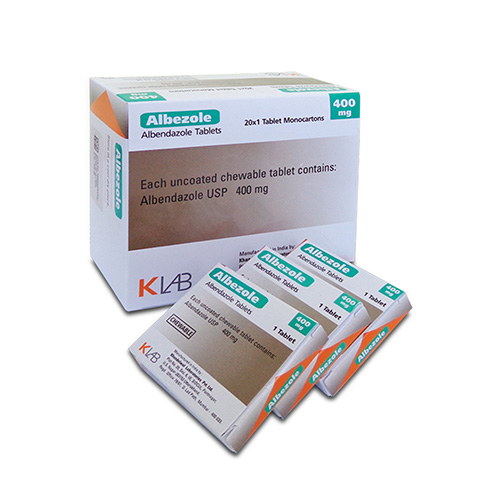
ALBEZOLE Tablet
Therapeutic Class
Anthelmintics
Indications
Albendazole is indicated for the treatment of the following infections: Neurocystiscercosis: Albendazole is indicated for the treatment of parenchymal neurocysticercossi due to active lesions caused by larval forms of the pork tapeworm, Taeniasolium. Lesrons considered responsive to albendazole therapy appear as non-enhancing cysts with no surrounding edema on contrast-enhanced computerized tomography. Clinical studies 10 patients with lesions of this type demonstrate a 74% to 88% reduction in number of cysts; 40% to 70% albendazole treated patients showed resolution of all active cysts. Hydatid Disease: Albendazole is indicated for the treatment of cystic hydatid disease of the liver, lung and peritoneum, caused by the larval form of the dog tapeworm, Echinococcus granulosus.
Chemical Composition
Each uncoated chewable tablet contains:
Albendazole USP 400 mg
Packaging
20 x 1's/ Box
Contraindications
Albendazole is contra-indicated in patients with known hypersensitivity to the benzimidazole class of compounds.
Warning & Precautions
Patients being treated for neurocysticerosis should receive appropriate steroid and anticonvulsant therapy as required. Oral or intravenous corticosteroids should be considered to prevent cerebral hypertensive episodes during the first week of anticysticeraf therapy. Cysticercosis may, in rare cases, involve the retina. Before initiating therapy for neurocysticercosis, the patients should be examined for the presence of retinal lesions. If lesions are visualized, the need for anbcysticeral therapy should be weighed against the possibility of retinal damage caused by albendazole-induced changes to the retinal lesion.
Drug Interaction
Dexamethasone: Steady-state trough concentrations of albendazole sulfoxide were about 56% higher when 8 mg dexamethasone was co-administered with each dose of albendazole (15 mg/kg/day) in eight neurocysticerosis patients. Praziquantel: In the fed state, praziquantel (40 mg/kg) increased mean maximum plasma concentration and area under the curve of albendazole sulfoxide by about 50% in healthy subjects (n=10) compared with a separate group of subjects (n=6) given albendazole alone. Mean Tmax and mean plasma elimination half-life of albendazole sulfoxide were unchanged. The pharmacokinetics of praziquantel were unchanged following co-administration with albendazole (400 mg). Cimetidine: Albendazole sulfoxide concentrations in bile and cystic fluid were increased (about 2-fold) in hydatid cyst patients treated with cimetidine (10 mg/day/kg) (n=7) compared with albendazole (20 mg/kg/day) alone (n=12).Aibendazole sulfoxide plasma concentrations were unchanged 4 hours after dosing. Theophylline: The pharmacokinetics of theophylline (aminophylline 5.8 mg/kg infused over 20 minutes) were unchanged following a single oral dose of albendazole (400 mg) in 6 healthy subjects.

